A rise in shark sightings near US beaches may be alarming to some, but an expert has said Americans need to get used to sharing their summers with these apex predators.
Chris Fischer, the founder of OCEARCH, told the Daily Mail populations have bounced back from the brink of extinction over the last 30 years, and it’s leading to a major resurgence of all creatures in the ocean.
‘Scientists came to us in 2006 and said, ‘We have an issue here, Chris, we’re down to nine percent of our large sharks worldwide,” Fischer explained.
‘We’re seeing ecosystems kind of collapse when we lose the sharks because the sharks are the apex predator, the balance keepers of these systems,’ Fischer said.
However, thanks to multiple efforts in the US to ban practices that kill sharks and wipe out their food sources, Fischer said beachgoers are seeing levels of shark activity that hasn’t been seen since the 1950s.
‘I think there are far more white sharks, if we’re talking about large sharks, off our coast than people think there are,’ the expedition leader revealed.
‘There is no way that we have captured more than a fraction of one percent. I think that you’re looking at tens of thousands of them, certainly 10,000 of them most of the time,’ Fischer added.
Overall, there are between 50 and 70 different kinds of sharks that are regularly seen around the US coastlines, according to the National Oceanic and Atmospheric Administration (NOAA).

OCEARCH recently tagged ‘Contender’ in January, a white shark that’s close to 14 feet and weighs over 1,600 pounds
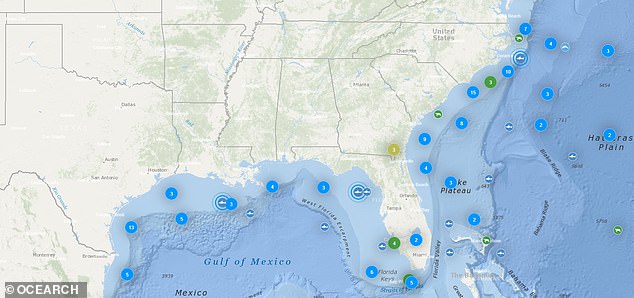
The nonprofit marine research group OCEARCH has tagged and tracked 92 white sharks along the US coastline over the last decade
Those include the blacktip, sandbar, spiny dogfish and white sharks. The so-called great white shark has become famous – or infamous – because of movies such as Jaws, which sensationalized the threat of shark attacks near US beaches.
Fischer noted there’s actually no such thing as a ‘great white shark,’ and the named was changed from white shark for dramatic effect in movies like these.
Shark numbers, including the white shark, typically swell in the summer as these predators return to their breeding grounds and search for prey in the warmer waters along the beachfront.
However, the marine researcher called the belief that sharks have been moving closer to crowded US shorelines because of climate change a ‘bizarre, fabricated concept.’
‘We’ve all been swimming with all kinds of sharks all our lives now, because the ocean is returning to abundance,’ Fischer revealed.
Abundance refers to having a healthy, thriving population of various species in the ocean, where there are enough animals to keep the ecosystem balanced and functioning properly.
OCEARCH is a non-profit group focused on shark research and ocean conservation. They’ve conducted expeditions to study and tag sharks, collecting data on their movements and biology to support marine conservation efforts in the US.
‘We’ve now successfully returned our ocean to abundance. So yes, we’re going to be seeing things that people think are unusual, but that’s actually what what the ocean is supposed to look like,’ the OCEARCH founder added.

Chris Fischer, the founder of OCEARCH, told the Daily Mail that conservation efforts since the 1990s have led to a resurgence of all creatures in the ocean
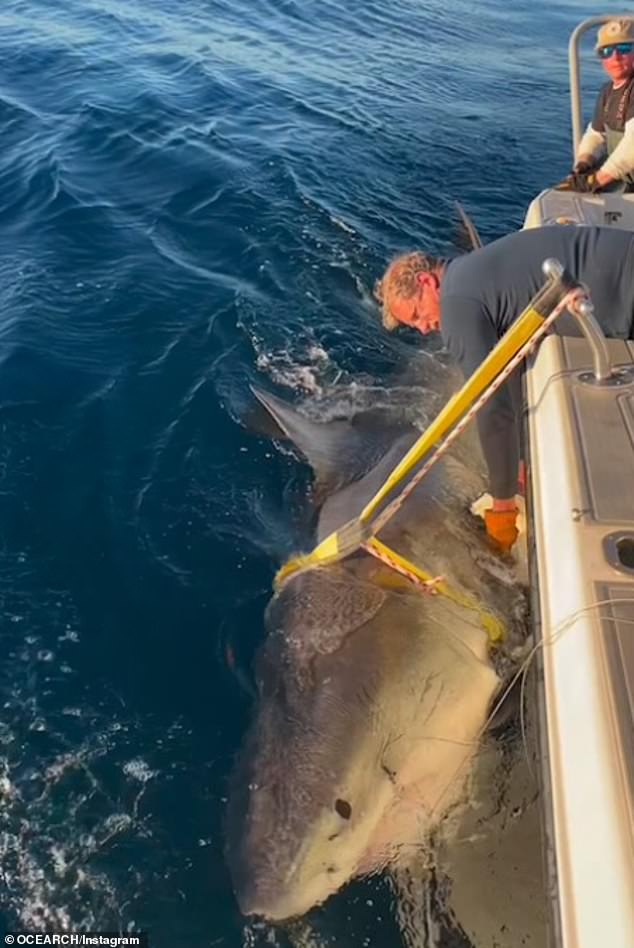
Contender (pictured) is a massive white shark that has been tracked heading up the US East Coast towards the Carolinas and Virginia
Fischer noted several major factors that are driving up shark sightings and misconceptions that these creatures have become more of a danger to US beaches in recent years.
Perhaps most importantly, the OCEARCH founder said that the COVID pandemic has thrown off people’s perceptions of what’s in the ocean.
Due to many of the conservation efforts that took place right before the US went into lockdown, many marine species started to boom again – a process that was further aided by fewer humans out on the water.
‘Everyone went away for COVID, and just around the same time we passed the Forage Fish Protection Act. They came back down to the beach two years later and all of a sudden there was bait everywhere, and all the fish we’d managed back,’ Fischer said.
‘You’re getting to see what your great granddaddy used to watch here at the beach. You just have never seen in your life because we had compromised the system so badly. And now it’s back,’ he continued.
Fischer explained that it’s also not global warming that brings sharks closer to the shore, it’s a normal method of hunting called ‘crowding’ which sharks use to corner bait fish like mackerel, sardines, and anchovies.
Sharks push these abundant species into the shallower waters closer to the beach so they’re easier to eat.
The researcher noted that the white shark plays an especially key role in population control and ecosystem balance for these other species in US waters.
‘If you think about every species in [the ocean]. It’s like an orchestra, and every species is a different instrument, and the white shark is the conductor,’ Fischer said.
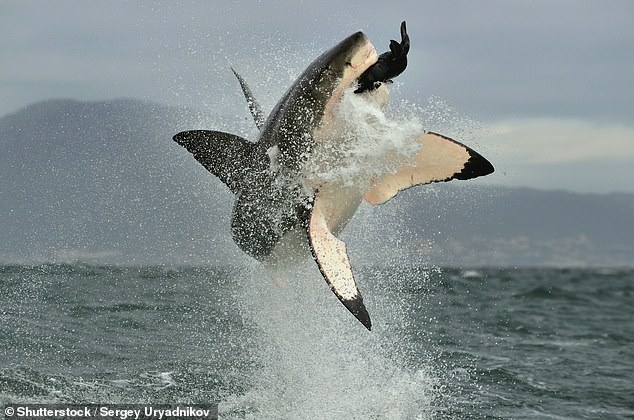
Sharks have relatively good eyesight underwater, but they can have trouble distinguishing between a seal and a person on a surfboard (Stock Image)
With more legislation against the overfishing of certain species, like the Forage Fish Protection Act of 2020, and the banning of deadly inshore gill nets in the 1990s, marine populations have been thriving.
Not only are there more sharks, there is more of everything in sea, meaning sharks have more to feed on and are getting much bigger.
In January, OCEARCH tagged and began tracking the white shark named Contender, a 14-foot, 1,600-pound behemoth discovered near the coast of Georgia.
He’s the largest male white shark researchers have encountered in the Atlantic, but it’s possible that record won’t last for long.
Fischer explained that the devastation of shark populations in the 70s and 80s primarily wiped out larger, ancient sharks.
These predators can live for roughly 70 years and don’t even become sexually mature until they reach the age of 30.
‘The first sharks we began protecting back in the early 90s, late 80s are just now becoming sexually mature. So that means the only really big animals out there are the ones that survived us,’ the researcher said.
Fischer added that it’ll still be decades before today’s young sharks reach their maximum size in the wild, so Contender could still be growing.
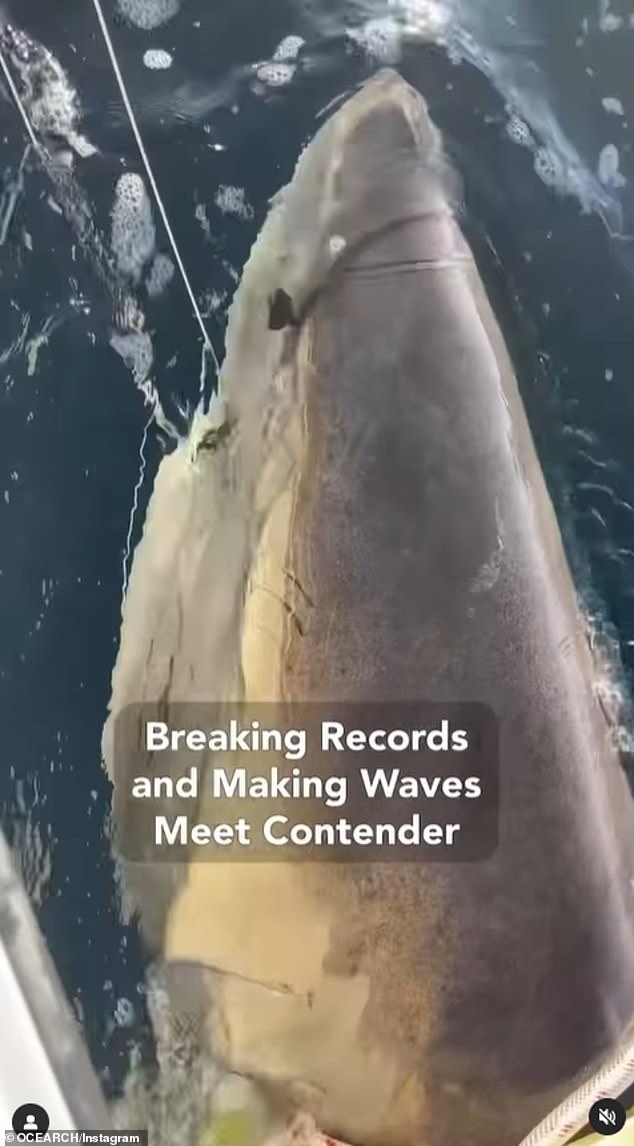
Contender (pictured) is much larger than the average male shark, which measures between 12 and 13 feet in length
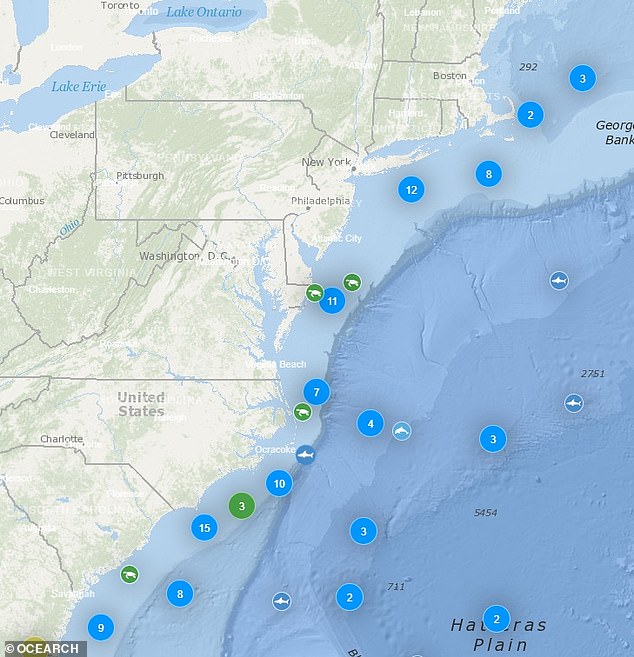
Researchers have been tracking sharks all the way up the East Coast, even into New England
Although shark hotspots like Florida, California, and Hawaii continue to bring the greatest chance of a shark encounter, Americans vacationing in the Carolinas, Texas, New York, and New Jersey should stay alert when they head into the water.
In fact, South Carolina (120) and North Carolina (81) currently rank fourth and fifth in terms of confirmed shark attacks in the US over the last two centuries.
Florida is far and away the shark attack capital of the US with 942 attacked since 1837, according to the University of Florida’s International Shark Attack File.
Hawaii ranks as a distant second with 199 confirmed attacks. Many of these attacks involved tiger sharks, which are known for their tremendous size (up to 18 feet in length) and their reputation for eating anything from fish to sea birds.
California has seen the third-most attacks in recorded history, with the vast majority involving white sharks.
